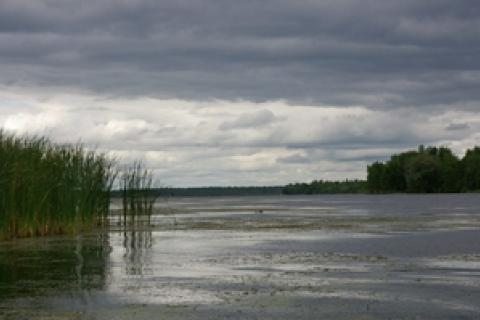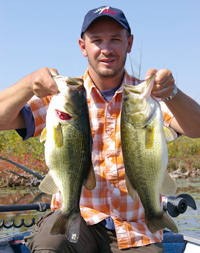
We've all had to face it at one time or another -- waking up on the day of your fishing trip to a chill in the air and bluebird skies to boot. What you are experiencing is the passing of a cold front, a weather occurrence that can shut down fish and cause severe headaches for an angler. Fishing will be tough -- there's no two ways about it -- but it is possible to put some fins in the boat if you are prepared to alter your delivery.
 Try these fishing techniques the next time you have the "cold front blues," and watch your catch rate increase dramatically.
Try these fishing techniques the next time you have the "cold front blues," and watch your catch rate increase dramatically.
What is a Cold Front & How Does it Affect Fishing?
A common definition of a cold front is "A narrow zone of transition between relatively cold, dense air that is advancing and relatively warm, less dense air that is retreating."
A cold front actually takes place a day or so before the drop in temperature sets in and the skies become blue. This typically shows itself in the form of high winds, rainy weather or thunderstorms. It's those kinds of days where all hell breaks loose, as the approaching front is causing a disturbance as the differing masses come together.
As the cold front approaches, fishing can be excellent. Fish become wired and active, feeding up a storm and hitting baits with ferocious strength. Even the fish know that once the front passes, they will take on a neutral or negative mood and develop a case of lockjaw for a couple of days. So, they feed heavily in preparation for this "dormant" stage.
If you can get out on the water as a front approaches, I would certainly suggest it. Enjoy it while you can, because within a day or so, things will be much different.
Post-cold front conditions vary greatly from the actual cold front. Clear blue skies, calm winds and colder temperatures are the norm, not the exception. The change in pressure and temperature seems to shut down the fish, causing them to retreat to heavier cover, sulk on bottom structure and become extremely inactive. Now is when you have your work cut out for you.
Where to Find Fish After a Cold Front
After a cold front has passed, fish stage in predictable areas of a lake or river. Don't expect fish to be moving around much, nor will there be much activity in the open water shallows.
For largemouth bass, thick vegetation or heavy cover (boat docks or pilings) is a good place to start. Under these circumstances most fish will snuggle into the security of some sort of structure, content to sit still and wait out the changing weather. In my experience, the thicker the cover you can find, the better your chances of having Mr. Bucketmouth present.
Depending on the type of lake, walleye will either seek out a thick weedbed and position themselves smack dab in the middle, or if rocks and boulders are concerned, they will sit right on bottom, remaining primarily motionless.
No matter what the specie, seeking out the shelter and comfort of thick vegetation or other structure is a likely scenario. Remaining in a neutral or negative mood is a given.
Adapting to the Weather Conditions for Fishing
Although it may seem like a lost cause to even head out on the water, fish can still be caught if you are willing to alter your approach. Here are some techniques that will certainly up your odds:
1. Downsize Your Fishing Lures
 |
| In the author's fishing experience, the thicker the cover you can find, the better your chances of having Mr. Bucketmouth present. |
Although a largemouth bass may have no trouble hitting a ten-inch worm during a "normal" day of fishing, he certainly won't be as forthcoming after a front has moved through. Scale back the size of the lures you are tossing, downgrading to finesse style baits for a better reaction. Since you are downsizing your lures, lowering the thickness of your line is also a good idea. Not only will get more of a lifelike action with your baits, but also less likelihood of scaring away line-shy fish.
Lightweight fishing lures and line are most certainly in, and will often be the only thing that gets the attention of a heavyweight.
2. S-l-o-w It Down
When fish are inactive, the last thing they want to do is chase down a fast moving buzzbait or spinnerbait cranked at a lightning-fast tempo. They just won't exert the energy, nor do they have the initiative to do so.
Work your baits in "slow motion." Even when it seems excruciatingly painful to fish your worm or tube with nary a movement, stick with it. If anything, slow it down even more. Deadsticking a bait is a great technique that can bring positive results.
3. Think Vertical Instead of Horizontal Baits
A neutral fish has a small strike zone or feeding window. What this means is, unless a lure comes within six-inches or a foot (as an example) to a fish's snout, he will not be willing, or convinced to strike it. The closer you can get to the strike zone, the better your chances for success.
Vertical baits work well in this situation because they spend more time in the strike zone, as opposed to horizontal baits that move through relatively quickly.
Fishing flipping jigs in heavy cover, tubes on rock shoals or worms under docks — they all work well because they drop down to where the fish is positioned, and stay there until a fish strikes, or decides against it. Vertical baits also work well because they can be worked much slower and precisely than horizontal ones, causing a fish to react more willingly.
4. Switch to Livebait
When the fish are finicky, switching to God's lures is the way to go. Yep, you guessed it — livebait. Minnows, worms or leeches will all work well and play on a fish's natural prey preference.
Slip floats, livebait rigs and tipped jigs all have a time and place, and post cold front conditions are definitely one of them.
Try to use the freshest and liveliest bait you can get your hands on. The better the action and smell, the more chance a fish will fall for it.
5. Scent Your Artifical Fishing Bait
If livebait isn't available to you, making your artificials smell and taste like the real thing is the next best thing to do. Go with tried-and-true fish scents, including crawdad, shad and worm. Any extra second you can get a fish to bite and hold on, is an extra second you can get those hooks into him.
Cold fronts don't have to be all about doom and gloom. Although the fish may have changed locations and be reluctant to strike baits, this doesn't mean they are uncatchable. Spend some time on the water after a cold front and prepare to experiment. it usually takes is a change of tactics to get into some fish again.
- 29950 views

